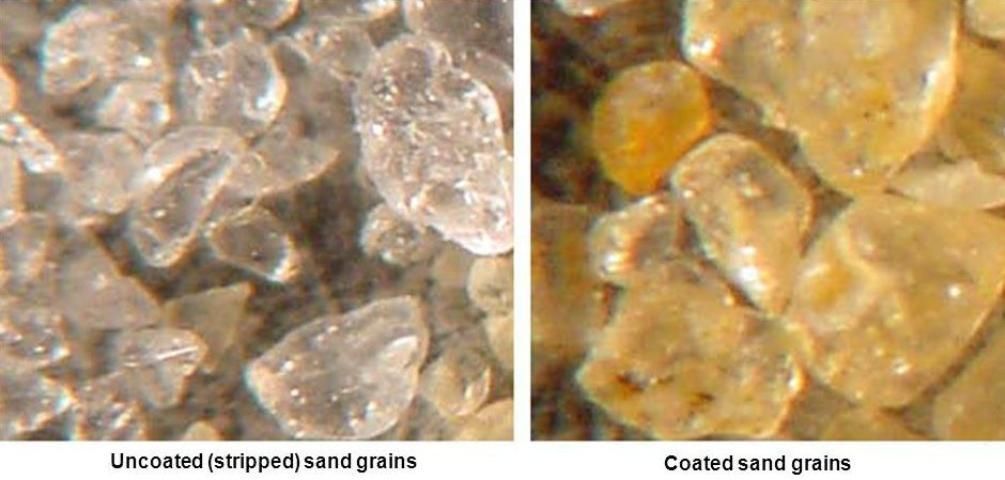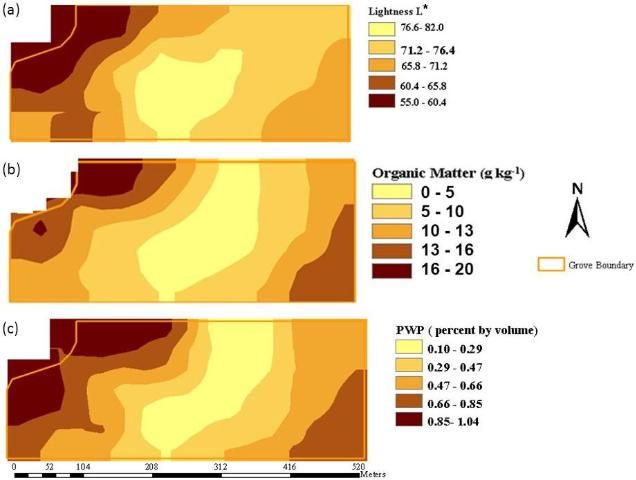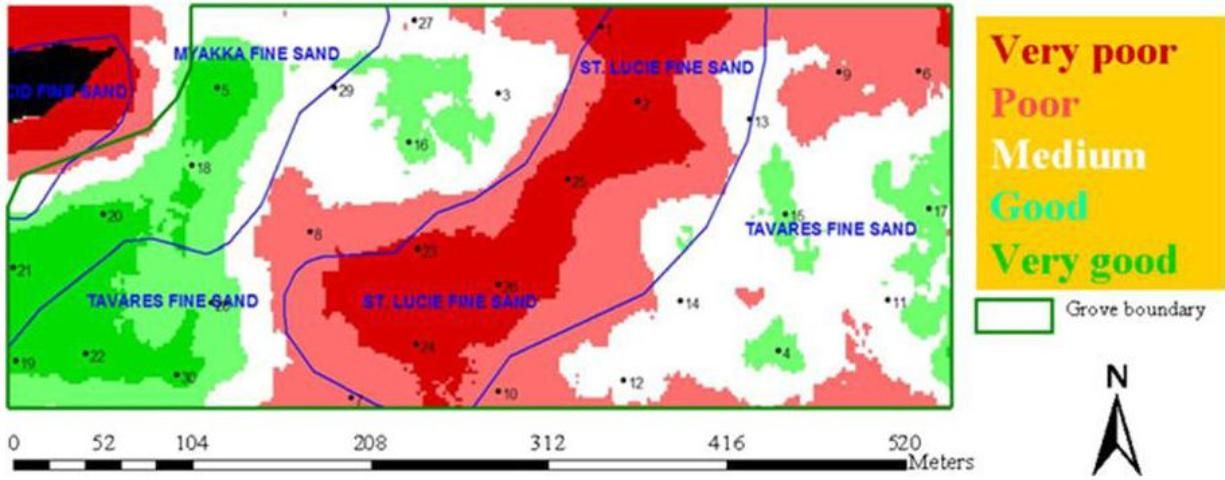Non-uniform tree growth and fruit yield are very common throughout many Florida citrus groves, particularly on sandy, flatwoods soils. In some cases, groves contain large, localized areas that do not support good growth and yield. Localized reduction in yield can affect as much as one-quarter of a given field. Nevertheless, variable groves are typically managed as if they were uniform. Uniform management of large citrus groves could result in under-fertilization of high-yielding areas (thus limiting yield) and over-fertilization of low-yielding areas, which may lead to nutrient leaching and environmental contamination. Uniform fertilization of a non-uniform grove decreases net economic returns because of the failure to attain yield potential and wasted fertilizer in variable groves. Therefore, optimal crop production efficiency and profitability cannot be achieved if a non-uniform grove is managed as a single, uniform unit.
The objectives of this publication are to 1) provide information about the relationship between soil variability and citrus production, 2) propose recommendations for soil sampling that account for spatial variability, and 3) suggest site-specific management practices for variable Florida citrus groves.
Technology to Characterize and Manage Yield Variability
Citrus production managers are well aware of non-uniformity within their fields, but previously they did not have tools to manage variable soils. The introduction of "site-specific crop management" (SSCM), also known as precision farming, can be a valuable tool to increase the productivity of citrus groves that have spatially variable tree growth and yield. Using precision farming technologies, specific zones within a field are managed with different levels of input according to each zone's specific requirements. SSCM technology includes the global positioning system (GPS) and geographic information system (GIS) for producing maps, combined with yield monitoring, remote sensing, and variable rate application equipment. Each crop production unit (down to a single tree level if desired) can be managed with inputs on a site-specific basis to reduce waste, increase profits, and maintain environmental quality. There is high potential to adopt precision agriculture technologies in citrus production where site-specific tree growth and fruit yield can be mapped and related to site-specific soil characteristics. Using special spatially linked statistical tools (geostatistics), mapped survey data can be analyzed and interpolated from sampled points to unsampled locations. Therefore, precision soil sampling schemes coupled with geostatistics can improve the analysis of field soil properties by quantifying and mapping the spatial variation of the measured properties within the field. In addition, SSCM using variable-rate fertilizer application is more favorable economically compared with uniform application. SSCM of variable fields requires identifying the major soil properties that affect citrus production. To explore these relationships, we evaluated variation in tree growth, fruit yield, and soil properties within a variable citrus grove in Hardee County.
Soil Properties Responsible for Tree Growth and Yield Variability
The primary factors responsible for yield variation are the occurrence of different soil series and/or the exposure of less fertile subsoil during grove leveling or bedding. Non-uniform citrus groves exhibit variable soil color that corresponds to tree variability, indicating that soil variability is responsible for localized yield reduction. Poor growth areas in a grove have a much "lighter" soil color (or high value, in Munsell soil color terminology) than surrounding productive areas (Figure 1). The presence of light-colored soils in poorly productive areas indicates that these soils are devoid of darker-colored coatings on sand particles. Iron and aluminum oxides and hydroxides are common cementing agents that coat sand grains in many Florida soils, and these coatings effectively bind fine particles to sand grains. These coatings increase the otherwise negligible surface area of sandy soils and are responsible for their increased nutrient-holding capacity. Sand grain coatings are the primary feature that differentiates the more highly productive grove areas (with coated sands) from the areas of lower productivity (with non-coated or "stripped" sands) (Figure 2).

Credit: Google Earth

Credit: UF/IFAS
The map of soil color lightness in the Hardee County citrus grove (Figure 3a) exactly followed the patterns of tree growth and production (Figure 1). Soil color was significantly correlated with citrus grove productivity. The low-producing soil areas in the middle of the field were much lighter colored (higher values of lightness) compared with the soil in the surrounding productive areas. Soil color also relates to variations in organic matter content, with darker colors representing high organic matter content. The spatial distribution of organic matter in the top 24 inches of soil (Figure 3b) showed very low values (< 0.5%) along a north-south line across the center of the grove and higher values along the eastern and western edges. Organic matter is the single most important indicator of soil quality and productivity in most cases, and it is severely deficient in low-producing areas. Organic matter is of particular interest because of its role in improving nutrient- and water-holding capacity, soil structure, and as a precursor for biochemical transformations that occur in the soil. However, organic matter varies greatly within Florida citrus groves, and its variation is strongly and positively correlated with yield variability.
In addition to organic matter, soil color also relates to moisture content. The spatial patterns of volumetric water content at permanent wilting point (15 bar soil moisture tension) (Figure 3c) were also similar to the patterns of organic matter and citrus tree growth. Florida citrus grove soils have sand content greater than 940 g kg-1 (94%), and about half of the soils sampled had sand content greater than 970 g kg-1 (97%). Hence, soil water retention is a major problem that limits Florida citrus production.

Credit: UF/IFAS
Comparing the variable patterns of soil properties with citrus tree growth (Figure 1) suggests that there are large variations in soil fertility along the productivity gradient. The spatial distribution of soil color, organic matter, sand grain coatings, and water retention identified the relative productivity of a non-uniform citrus grove. However, the present recommendation for soil analysis in Florida citrus groves does not include measurements of soil color or presence of sand grain coatings. Soil analysis in non-uniform groves should include these parameters to help quantify spatially variable productivity. The ability of easily measured soil properties to describe the productivity of various groves suggests that soil color or organic matter can be used to delineate management zones for SSCM.
Management of Soil and Yield Variability in Citrus Groves
Dividing the Grove into Different Management Zones
A variable citrus grove should be divided into different management zones based on relative tree size or productivity. A management zone is defined as a subregion of a field with homogeneous yield-limiting factors. Management zones based on areas of similar productivity or yield potential are an effective way to plan soil sampling and characterize spatial variability of soil. Information about soil properties and yield from the different management zones within a field can be used for fertilizer and soil amendment recommendations, and then the variable fields can be managed on a site-specific basis. To match the fertilizer application requirement of individual trees, it is important to map the yield potential of each tree if possible. Fertilizer application practices for commercial Florida citrus production are based on tree age and projected yield (Obreza, Zekri, and Hanlon 2008), and these properties can be related directly to tree size. We used ultrasonically measured tree canopy volume to divide the Hardee County grove into different productivity/management zones and to collect soil samples (Figure 4). Ultrasound-based measurement of tree canopy volume is a rapid method to estimate tree size, which is positively correlated with citrus fruit yield, and, therefore, it can be used to divide the variable citrus groves into different management units for SSCM.

Credit: UF/IFAS
Soil Sampling within the Management Zones
Management zones can be further used to develop future soil sampling plans. Further soil sampling can be conducted using a grid-based system, where grid size should be half of the distance beyond which the soil properties measured in the grove are no longer spatially dependent (also called range of spatial dependence). Most soil chemical and physical properties that we measured showed their maximum spatial dependence close to 500 ft. This information is useful because the sampling interval for new surveys typically should be less than half of the average range. Therefore, the range of soil properties in this study suggested a sampling interval of less than 250 ft within the grove, which corresponds to a grid size of less than 1.5 acres. Soil and leaf tissue testing procedures recommended for Florida citrus groves divide the grove into a management unit of 20 acres. This area is slightly less than the total area of the citrus grove in our study (25 acres; Figure 1), which represented a large variability in soil properties and citrus production. Therefore, soil sampling intervals in new fields should be based on the range of easily measured soil properties instead of using fixed sampling intervals.
Variable Rate Fertilizer Application
Knowledge about how soil properties vary can help develop prescription maps and will allow the manager to match production practices with variations in crop growth, soil type, soil fertility, and moisture. The current fertilization strategy for Florida citrus groves involves determining an average fertilizer need for the whole grove and then applying a single rate to the entire field. However, with this strategy, some areas of the field receive more than the optimum amount of fertilizer needed while other areas may not receive enough. Grove managers should apply the fertilizer based on the soil fertility tests for specific areas of the field. They should apply fertilizer at the appropriate amount only where it is needed instead of applying a single rate throughout the field. This can be achieved by implementing SSCM using variable rate fertilization. This technology allows growers to apply different rates of fertilizer at different locations of a field. Variable rate fertilization equipment for citrus is commercially available and is used in modern citrus production. Variable rate fertilization will also reduce production costs and prevent environmental contamination by reducing excess fertilizer application to unproductive areas of fields where nutrient uptake is low and losses may occur.
Improving the Unproductive Areas
Characterizing soil variability will help when making decisions about the land use in weak portions of fields. Based on the knowledge of key soil properties, these areas can be excluded or possibly improved by applying the appropriate amendments at the time of planting. Plans to make the unproductive areas in fields perform better should be based on soil analysis. Organic and inorganic soil amendments of waste by-products like phosphatic clay, municipal compost, and iron humate can be applied to poor areas of the grove at weight equivalent of 5%. These by-products are often provided at no cost other than transportation. Therefore, their application should be planned based on the proximity of a suitable supply and transportation, spreading, and incorporation costs. Soil amendments can be applied at the time of planting in new fields and to replanted trees in established groves. In new fields, the amendments can be applied down to the root zone (up to 18–24") depth of each tree in the weaker areas, which can be a cost-effective method to improve the weak portions of the field. Second, the amendments can also be surface-applied in established groves along tree rows in poor areas, allowing crop production and revenue to increase within a few years. For this practice, a grower should identify the weaker soils in the grove and apply soil amendments to those areas only.
Summary
Variability of soil chemical and physical properties (e.g., soil color, organic matter, coatings on sand grains, and water retention) is a major factor responsible for non-uniformity of tree performance in Florida citrus groves. To manage non-uniform groves, soil samples should be collected from different areas, identified as "productivity zones" (i.e., areas of similar tree growth or yield). Variation in tree growth or soil properties can be used to map grove productivity to subdivide the grove into different management zones. These management zones can be used to target future soil sampling to characterize soil variability. Soil in new groves should be sampled based on half of the average range of easily measured soil properties such as organic matter and soil color. Information about soil properties and yield from different management zones within a field can be used for optimum placement of fertilizers and soil amendments on a site-specific basis. The SSCM of variable groves using variable rate equipment would help to avoid over- and under-applications of fertilizer, which can optimize yields and minimize the potential for nutrient losses. Organic and inorganic soil amendments should be applied to areas of poor growth to increase their productivity.
References and Articles for More Information
Ehsani, R., A. Schumann, and M. Salyani. 2009. Variable Rate Technology for Florida Citrus. AE444. Gainesville: University of Florida Institute of Food and Agricultural Sciences. http://ufdc.ufl.edu/IR00003314/00001
Mann, K.K., A.W. Schumann, and T. A. Obreza. 2011a. "Delineating Productivity Zones in a Citrus Grove Using Citrus Production, Tree Growth and Temporally Stable Soil Data." Precision Agriculture 12 (4):457-72. doi:10.1007/s11119-010-9189-y.
Mann, K.K., A.W. Schumann, T.A. Obreza, M. Teplitski, W.G. Harris, and J.B. Sartain. 2011b. "Spatial Variability of Soil Chemical and Biological Properties in Florida Citrus Production." Soil Science Society of America Journal 75. doi:10.2136/SSSAJ2010.0358.
Obreza, T.A., M. Zekri, and E.W. Hanlon. 2008. "Soil and Leaf Tissue Testing." SL253. In Nutrition of Florida Citrus Trees, 2nd edition, edited by T.A. Obreza and K.L. Morgan, 24-32. Gainesville: University of Florida Institute of Food and Agricultural Sciences. https://edis.ifas.ufl.edu/ss478.
Zaman, Q., and A.W. Schumann. 2006. "Nutrient Management Zones for Citrus Based on Variation in Soil Properties and Tree Performance." Precision Agriculture 7: 45-63.